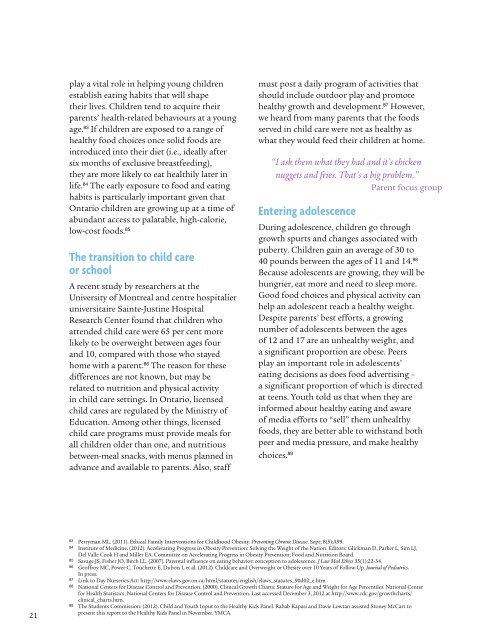No Time to Wait: The Health Kids Strategy - Ontario
No Time to Wait: The Health Kids Strategy - Ontario
No Time to Wait: The Health Kids Strategy - Ontario
- No tags were found...
Create successful ePaper yourself
Turn your PDF publications into a flip-book with our unique Google optimized e-Paper software.
play a vital role in helping young childrenestablish eating habits that will shapetheir lives. Children tend <strong>to</strong> acquire theirparents’ health-related behaviours at a youngage. 83 If children are exposed <strong>to</strong> a range ofhealthy food choices once solid foods areintroduced in<strong>to</strong> their diet (i.e., ideally aftersix months of exclusive breastfeeding),they are more likely <strong>to</strong> eat healthily later inlife. 84 <strong>The</strong> early exposure <strong>to</strong> food and eatinghabits is particularly important given that<strong>Ontario</strong> children are growing up at a time ofabundant access <strong>to</strong> palatable, high-calorie,low-cost foods. 85<strong>The</strong> transition <strong>to</strong> child careor schoolA recent study by researchers at theUniversity of Montreal and centre hospitalieruniversitaire Sainte-Justine HospitalResearch Center found that children whoattended child care were 65 per cent morelikely <strong>to</strong> be overweight between ages fourand 10, compared with those who stayedhome with a parent. 86 <strong>The</strong> reason for thesedifferences are not known, but may berelated <strong>to</strong> nutrition and physical activityin child care settings. In <strong>Ontario</strong>, licensedchild cares are regulated by the Ministry ofEducation. Among other things, licensedchild care programs must provide meals forall children older than one, and nutritiousbetween-meal snacks, with menus planned inadvance and available <strong>to</strong> parents. Also, staffmust post a daily program of activities thatshould include outdoor play and promotehealthy growth and development. 87 However,we heard from many parents that the foodsserved in child care were not as healthy aswhat they would feed their children at home.“ I ask them what they had and it’s chickennuggets and fries. That’s a big problem.”Parent focus groupEntering adolescenceDuring adolescence, children go throughgrowth spurts and changes associated withpuberty. Children gain an average of 30 <strong>to</strong>40 pounds between the ages of 11 and 14. 88Because adolescents are growing, they will behungrier, eat more and need <strong>to</strong> sleep more.Good food choices and physical activity canhelp an adolescent reach a healthy weight.Despite parents’ best efforts, a growingnumber of adolescents between the agesof 12 and 17 are an unhealthy weight, anda significant proportion are obese. Peersplay an important role in adolescents’eating decisions as does food advertising –a significant proportion of which is directedat teens. Youth <strong>to</strong>ld us that when they areinformed about healthy eating and awareof media efforts <strong>to</strong> “sell” them unhealthyfoods, they are better able <strong>to</strong> withstand bothpeer and media pressure, and make healthychoices. 892183 Perryman ML. (2011). Ethical Family Interventions for Childhood Obesity. Preventing Chronic Disease. Sept; 8(5):A99.84 Institute of Medicine. (2012). Accelerating Progress in Obesity Prevention: Solving the Weight of the Nation. Edi<strong>to</strong>rs: Glickman D, Parker L, Sim LJ,Del Valle Cook H and Miller EA. Committee on Accelerating Progress in Obesity Prevention; Food and Nutrition Board.85 Savage JS, Fisher JO, Birch LL. (2007). Parental influence on eating behavior: conception <strong>to</strong> adolescence. J Law Med Ethics 35(1):22-34.86 Geoffroy MC, Power C, Touchette E, Dubois L et al. (2012). Childcare and Overweight or Obesity over 10 Years of Follow-Up. Journal of Pediatrics.In press.87 Link <strong>to</strong> Day Nurseries Act: http://www.elaws.gov.on.ca/html/statutes/english/elaws_statutes_90d02_e.htm.88 National Centers for Disease Control and Prevention. (2000). Clinical Growth Charts: Stature for Age and Weight for Age Percentiles. National Centerfor <strong>Health</strong> Statistics, National Centers for Disease Control and Prevention. Last accessed December 3, 2012 at http://www.cdc.gov/growthcharts/clinical_charts.htm.89 <strong>The</strong> Students Commission. (2012). Child and Youth Input <strong>to</strong> the <strong>Health</strong>y <strong>Kids</strong> Panel. Rabab Kapasi and Davie Lowtan assisted S<strong>to</strong>ney McCart <strong>to</strong>present this report <strong>to</strong> the <strong>Health</strong>y <strong>Kids</strong> Panel in <strong>No</strong>vember. YMCA.
















